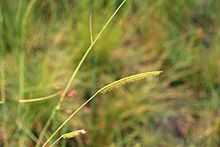Ctenium aromaticum
| Ctenium aromaticum | |
|---|---|
 | |
| Conservation status | |
| Scientific classification | |
| Kingdom: | Plantae |
| (unranked): | Angiosperms |
| (unranked): | Monocots |
| (unranked): | Commelinids |
| Order: | Poales |
| Family: | Poaceae |
| Genus: | Ctenium |
| Species: | C. aromaticum |
| Binomial name | |
| Ctenium aromaticum (Walter) Alph.Wood | |
Ctenium aromaticum is a species of grass known by the common name toothache grass. It is native to the southeastern United States, where it grows on the coastal plain.[1]
This is a perennial grass that forms clumps of stems reaching 1 to 1.5 meters in maximum height. The leaves are up to 46 centimeters long. The inflorescence is a panicle with one branch that is up to 15 centimeters long and lined on one side with two rows of spikelets. Each spikelet is roughly a centimeter long.[1]
It is not known whether or not the grass was ever used as a remedy for toothache. It has, however, been used as a sialagogue, an agent that increases saliva. The crushed roots have a strong scent.[2] The lower part of the stem produces a numbing sensation when it is chewed.[3] The agents responsible for this action are isobutylamides.[4]
References
- ↑ 1.0 1.1 Ctenium aromaticum. Grass Manual Treatment.
- ↑ Austin, D. F. and P. N. Ionychurch. Florida Ethnobotany. CRC Press 2004.
- ↑ Ctenium aromaticum. USDA NRCS Plant Fact Sheet.
- ↑ Gamboa-Leon, R. and W. S. Chilton. (2000). Isobutylamide numbing agents of toothache grass, Ctenium aromaticum. Biochemical Systematics and Ecology 28 1019-1021.
